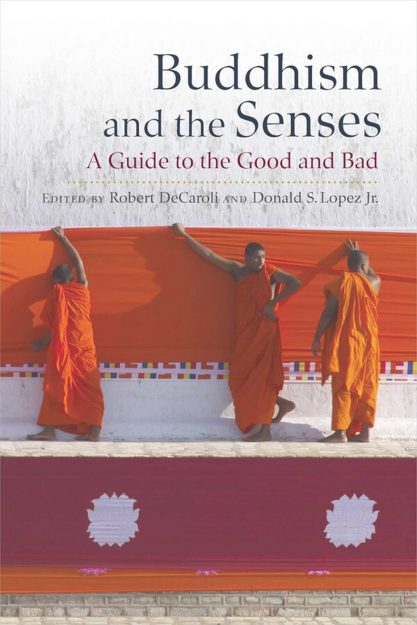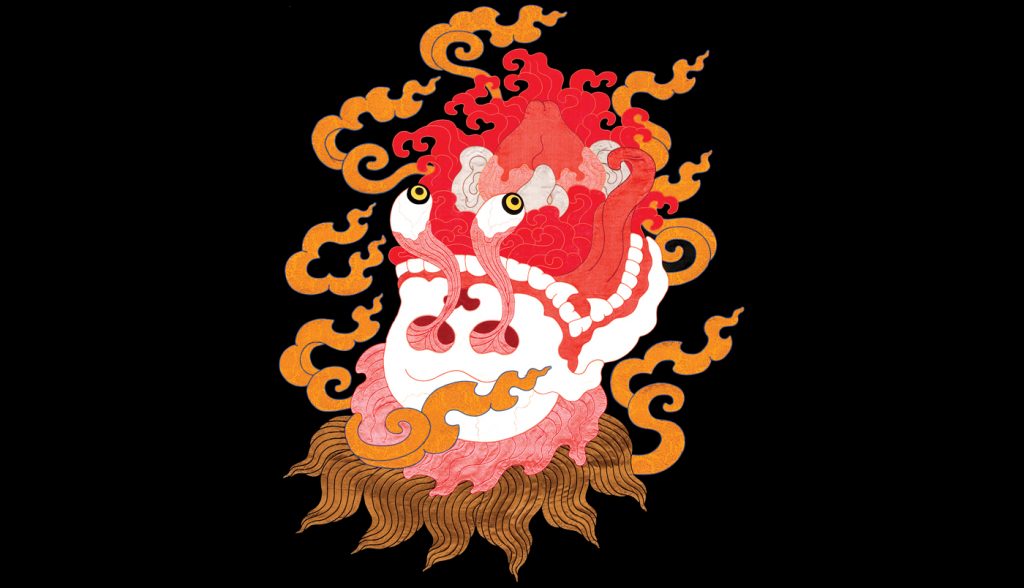Buddhism is often stereotyped as a world-denying religion, prizing austerity and denigrating sensory pleasure as the root of craving. Yet the full picture is much more complex: Scriptures like the Lotus Sutra recount the sensory splendors of buddha lands, abundant with otherworldly riches. Sweetness characterizes at once the origin of suffering and the end of it. And the Buddha’s own awakening and parinirvana are both described in terms of heavenly sights and smells.
As scholars Robert DeCaroli and Donald S. Lopez Jr. write, the tradition’s relationship to the senses “careen[s] between the extremes of indulgence and rejection, delight and disgust, rarely finding a middle way.” Within the academy, however, the complexities of Buddhism’s sensory worlds have been largely underexamined (as Lopez and DeCaroli quip, “it is striking how closely scholars of Buddhism have seemed to conform to the monastic order”). With their new edited volume, Buddhism and the Senses: A Guide to the Good and Bad, they are determined to change that narrative. Inspired by an exhibition at the National Museum of Asian Art, “Encountering the Buddha: Art and Practice Across Asia” (October 2017–January 2022), the collection features essays from ten prominent scholars that probe the subtleties of Buddhism’s attitude toward the senses, foregrounding material practice and somatic experience so as to shift readers’ understanding of Buddhism “from the conceptual to the practical, from the idealized to the human, from the abstract to the grounded, from the mind to the body.”
Buddhism and the Senses: A Guide to the Good and Bad
edited by Robert DeCaroli and Donald S. Lopez Jr.
Wisdom Publications, 2024, 264 pp., $39.95, hardcover
Recognizing Buddhism’s ambivalent relationship to the senses, the book is structured into ten chapters, each of which takes on one of the five senses in its positive or negative instantiation. Yet the chapters quickly unsettle this binary, drawing attention to the tensions and ambiguities inherent in attempts at simple categorization into “good” and “bad.” To provide readers with a visceral feel for these tensions, the volume is replete with all manner of sensory details ranging from the grotesque to the sublime, such as the moral and karmic dangers of garlic breath (including the risk of attracting kisses from lecherous hungry ghosts); the debates surrounding the Buddha’s final meal of “pig’s delight” and his subsequent death by dysentery; the spiritual benefits of rice porridge; a rigorous classification of sexual pleasure based on the Vinaya’s restrictions; and what the Buddha’s magical defenses against zombies can teach us about the perils of contagion in the Buddhist world.
Sweetness characterizes at once the origin of suffering and the end of it.
Some of the book’s most dazzling examples of “good” senses pertain to the Buddha’s own extraordinary sense faculties. We learn that when the Buddha speaks a single syllable, everyone present will understand it as a full discourse in their own language directed specifically to them. His body smells like fresh blossoms and sandalwood, and his scent is powerful enough to mask foul odors—a rare ability that allows him to travel to the heavens and facilitate communication between humans and the gods, as gods are typically too disgusted by the stench of humanity to bear human contact. What’s more, his tongue is long enough to lick behind his ears and wide enough to cover his entire face—and, through his perfect sense of taste, it can transform the taste of horse feed into that of celestial ambrosia.
As the contributors demonstrate, the senses become all the more significant in ritual practices after the Buddha’s death, as they—to different extents—mediate devotees’ access to him in his absence. In Thailand, for instance, Buddha images play a crucial role in what Melody Rod-ari calls the moral economy of merit-making: Seeing an image of the Buddha generates faith, which reinforces the importance of giving, thereby materially sustaining the sangha. In fact, the first portrait of the Buddha, the sandalwood statue, was constructed specifically to ensure that worshippers could make offerings to the Buddha when he was not materially present.
Yet it is not only “good” images that inspire faith and thus sustain the merit-making economy: Hellish imagery can also stir viewers to the dharma. Rod-ari cites the example of the Phra Malai Klon Suat, a chanted recitation of the monk Phra Malai’s escapades through heaven and hell as he encounters hungry ghosts who entreat him to tell their living relatives to make merit so that they can be reborn in heaven. The story is rife with grisly—and humorous—anecdotes of karmic comeuppances, including government officials reborn as ghosts with testicles “bloated and stinking . . . like slimy snails,” and its vivid hellscapes are continually brought to life through artistic renderings, ritual reenactments, and even life-size displays in the “hell park” at Wat Saen Suk, or “Temple of a Hundred Thousand Joys.” As Rod-ari argues, this name is not meant to be ironic; such gruesome iconography is indeed cause for celebration, as it reinforces the teachings of the Buddha by reminding viewers of the karmic consequences of their actions. While such images may be conventionally labeled as “bad,” in a karmic framework they are in fact good insofar as they lead viewers to the Buddhist path and, in inspiring donations, support the sangha.
Kurtis R. Schaeffer adopts a similar analysis in examining the sonic worlds of The Tibetan Book of the Dead. At first hearing, the sounds of the bardo might be considered bad since they represent negative aspects of human experience—in the words of The Book, they “awe, frighten, and terrify, and cause much fatigue.” But Schaeffer claims that these sounds are not necessarily bad; they’re just misunderstood. In truth, they are the sounds of reality, offering directions toward enlightenment and out of the endless cycle of rebirth; it is the listener’s own limited perception that causes them to fail to recognize reality for what it is—and therefore keeps them trapped in samsara. These seemingly terrifying sounds thus carry with them the potential for freedom: If one can hear “the natural sound of Reality, reverberating like a thousand thunders simultaneously sounding,” and not flee, then one is liberated from all bewilderment and delusion.
Just as seemingly “bad sound” can actually be an instigator for enlightenment, “good sound” can have surprisingly sinister consequences, as Donald Lopez explores in the Questions of the Kinnara King Druma. In this Tibetan sutra, when King Druma begins to play the lute, even the most austere of arhats “trembled, shook, acted wildly, and danced around like small children.” By contrast, the bodhisattvas stay in their seats. As Lopez argues, the “good” sound of beautiful music is weaponized as a means of discrediting and humiliating the arhats and demonstrating the superiority of the Mahayana.
The distinction between “good” and “bad” becomes even blurrier when it comes to smell. As Lina Verchery argues, smell defies easy categorization and crosses boundaries of “past and present, contact and distance, matter and immateriality,” self and other. For these reasons, foul smell is closely linked to karma—and to the far graver moral transgressions of sex and contamination. Yet the same smells also carry liberatory potential. In the asubhabhavana, literally “meditation on the impure,” practitioners are instructed to contemplate a rotting corpse “completely reeking with stench and impurity” in order to gain insight into the nature of reality. The stench of death thus becomes a vehicle for liberation, as it forces the practitioner to reckon viscerally with the truth of impermanence. In Verchery’s analysis, “even the baddest of bad smells—like the universally repulsive smells of disease, decay, and death—can, in their very badness, reveal something arguably more true than what any good smell can show.” In this manner, sensory revulsion functions as a gateway for moral transformation.
While bad smells may lead practitioners to the dharma, true insight comes from transcending the distinction between good and bad. Verchery cites the Avatamsaka Sutra, which asserts that one mark of a bodhisattva is the ability to smell aromas and “perceive neither fragrance nor stench” but only the smell of reality itself. After all, as Dogen states in his Instructions for the Cook, notions of “good” and “bad” taste are the products of dualistic thinking, and with proper intention even the crudest of vegetables can become delicacies: “When one enters into the pure and vast oceanic assembly of the buddhadharma, superb delicacies are never seen and the flavor of crude greens does not exist: There is only the one taste of the great sea, and that is all.” In this paradigm, Buddhist practice has the power to fundamentally alter one’s relationship to sensory experience and transform how the faculties perceive the external world.
One of the book’s most memorable illustrations of this phenomenon comes from the Lotus Sutra, wherein the Buddha declares that if devotees recite and preserve the Lotus Sutra they will acquire “eight hundred qualities of the eye, twelve hundred qualities of the ear, eight hundred qualities of the nose, twelve hundred qualities of the tongue, eight hundred qualities of the body, and twelve hundred qualities of the mind,” which will adorn and purify their sense faculties. With their eyes, they will be able to see the entire cosmos; with their ears, they will hear the chants of bodhisattvas and the screams of the denizens of hell. With their enhanced sense of smell, they will be able to identify the fragrances of humans, gods, animals, and trees; they can even sense whether a woman is pregnant—and whether her unborn child will be happy. Their tongues will have the power to preach the dharma so as to attract all manner of buddhas and gods, and their bodies will become like crystal balls, giving them the ability to see the whole universe in their own flesh. Thus, the senses, properly harnessed through devotion, can become organs not of pleasure or pain but of knowledge—knowledge of things as they are; knowledge of reality in all its fullness and exquisite detail.
Perhaps this is one of the gifts of the volume as a whole: In expanding our understanding of Buddhism’s sensory worlds, it may also enhance our relationship to our senses, causing us to see, hear, smell, taste, and touch our worlds anew. Taking cues from the collection’s contributors, we might question our assumptions around what makes a sensation good or bad, noticing how our perceptions have been culturally and historically conditioned; we might encounter the liberatory power of disgust—or the insidious dangers of sweetness. And, like the reciters of the Lotus Sutra, we might expand our capacity to attend to the richness of our everyday sensory experience, honoring the extraordinary knowledge it holds.

Thank you for subscribing to Tricycle! As a nonprofit, we depend on readers like you to keep Buddhist teachings and practices widely available.
